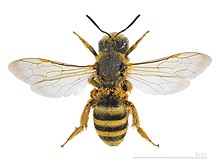
Back Groefby Afrikaans Halictidae Bulgarian Halíctids Catalan Halictidae CEB Ploskočelkovití Czech Vejbier (familie) Danish Halictidae German Haliktedoj Esperanto Halictidae Spanish Halictidae Basque
| Halictidae | |
|---|---|

| |
| Halictus scabiosae - MHNT | |
| Scientific classification | |
| Domain: | Eukaryota |
| Kingdom: | Animalia |
| Phylum: | Arthropoda |
| Class: | Insecta |
| Order: | Hymenoptera |
| Clade: | Anthophila |
| Family: | Halictidae Thomson, 1869, nom. protect. |
| Subfamilies | |
Halictidae is the second-largest family of bees[1] (clade Anthophila) with nearly 4,500 species.[2] They are commonly called sweat bees (especially the smaller species), as they are often attracted to perspiration.[3][4] Halictid species are an extremely diverse group that can vary greatly in appearance. These bees occur all over the world and are found on every continent[4] except Antarctica.[citation needed] Usually dark-colored (frequently brown or black) and often metallic, halictids are found in various sizes, colors and patterns. Several species are all or partly green and a few are red, purple, or blue.[4] A number of them have yellow markings, especially the males, which commonly have yellow faces, a pattern widespread among the various families of bees. The family is one of many with short tongues[5] and is best distinguished by the arcuate (strongly curved) basal vein found on the wing.[6] Females in this family tend to be larger than the males.[5] They are the group for which the term 'eusocial' was first coined by entomologist, Suzanne Batra.
- ^ Danforth, Bryan N.; Cardinal, Sophie; Praz, Christophe; Almeida, Eduardo A.B.; Michez, Denis (2013). "The Impact of Molecular Data on Our Understanding of Bee Phylogeny and Evolution". Annual Review of Entomology. 58 (1): 57–78. doi:10.1146/annurev-ento-120811-153633. ISSN 0066-4170. PMID 22934982.
- ^ "Bee Diversity". Museum of the Earth. Retrieved 2021-12-06.
- ^ "Sweat Bees". Missouri Department of Conservation. Archived from the original on 2015-09-26.
- ^ a b c "Sweat bees". Florida Wildflower Foundation. 2017-08-15. Retrieved 2021-12-06.
- ^ a b Hauze, Deena. "Halictidae (halictid bees, sweat bees)". Animal Diversity Web. Retrieved 2021-12-06.
- ^ "sweat bees, halictid bees". Featured Creatures. University of Florida Entomology and Nematology Department. Retrieved 21 September 2019.
© MMXXIII Rich X Search. We shall prevail. All rights reserved. Rich X Search